You’ve probably heard of BMI. Maybe you’ve even used a BMI calculator once or twice — typed in your height and weight, hit “calculate,” and stared at a number that claimed to say something about your body. But have you ever stopped to ask: What does that number actually mean?
BMI, or Body Mass Index, is everywhere — in gym assessments, doctor’s checkups, health apps, and yes, in nearly every online BMI index calculator. It’s a fast, simple tool. Yet beneath that simplicity lies a complex conversation about health, weight, and how we define what’s “normal.”
In this article, we’ll take a deeper look at BMI: where it comes from, how it’s calculated, why health professionals still use it — and why it’s not always the full picture. You’ll learn how to use a BMI calculator properly, understand its limitations, and discover when the number matters… and when it doesn’t.
What is BMI?
BMI stands for Body Mass Index, a number that reflects the relationship between a person’s weight and height. It’s calculated by dividing your weight in kilograms by the square of your height in meters (kg/m²). If you're using pounds and inches, the formula adjusts slightly:
BMI = (weight in pounds / height in inches²) × 703.
This calculation gives you a number that falls within a set range — and each range corresponds to a weight classification, such as underweight, normal weight, overweight, or obese.
But why do we use BMI in the first place?
The concept dates back to the 1830s when Belgian mathematician Adolphe Quetelet developed what he called the “Quetelet Index.” His goal wasn’t to assess individual health but to understand general trends in population body types. It wasn’t until the 1970s that American physiologist Ancel Keys revived the formula and coined the term Body Mass Index, promoting it as a practical, non-invasive method to estimate body fat in large-scale studies⁽¹⁾.
Today, health institutions like the World Health Organization (WHO) and Centers for Disease Control and Prevention (CDC) still rely on BMI as a screening tool — not a diagnostic one. According to the CDC, BMI is “an inexpensive and easy screening method for weight category — underweight, healthy weight, overweight, and obesity.”⁽²⁾
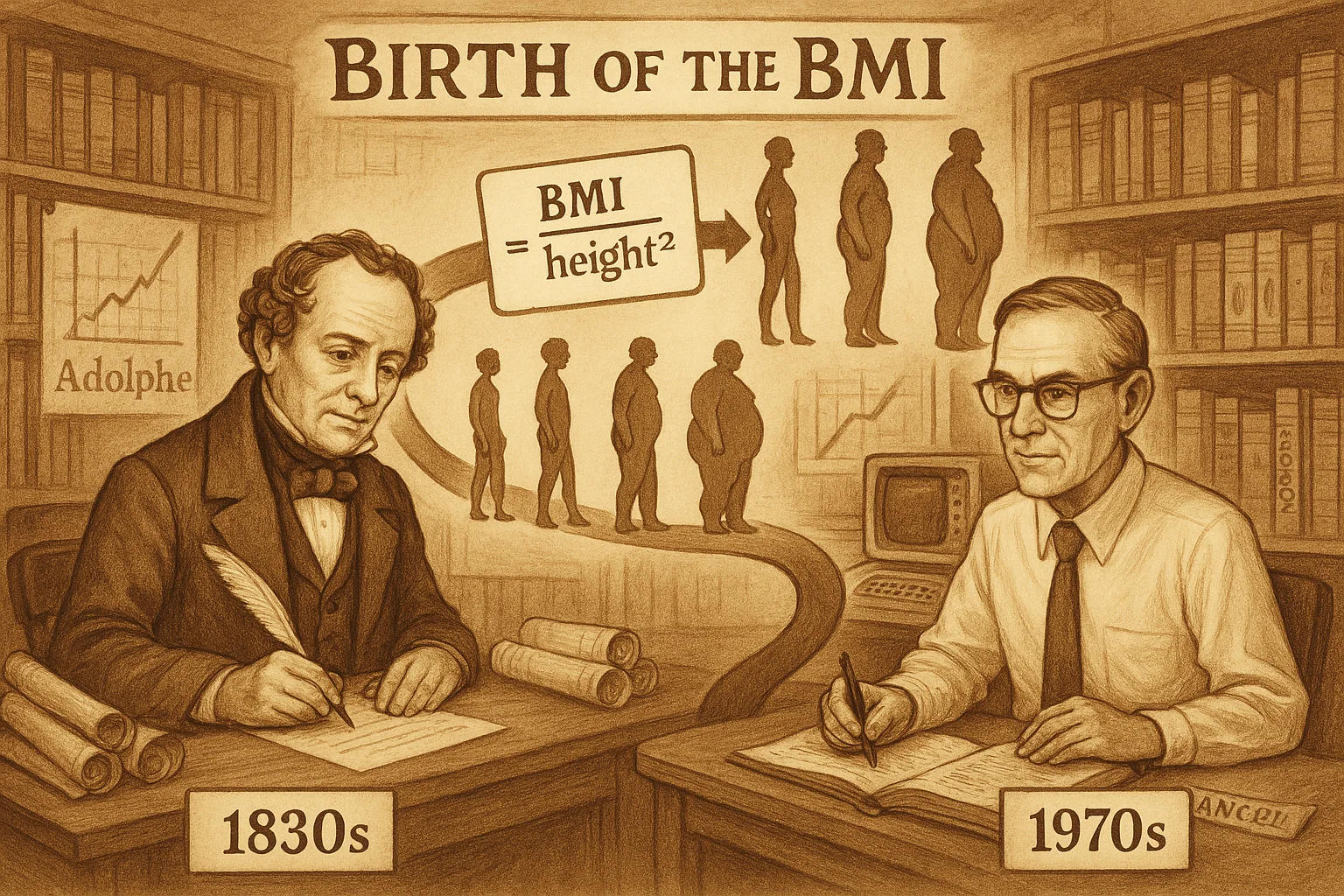
BMI Categories and What They Indicate
Once you calculate your BMI, you’re left with a number — but what does that number actually mean for your health?
That’s where BMI categories come into play. Health organizations like the World Health Organization (WHO) and the Centers for Disease Control and Prevention (CDC) use standardized BMI ranges to help classify individuals based on their weight status. These categories provide a general understanding of potential health risks associated with being underweight, overweight, or obese.
Here’s the breakdown of BMI categories for adults aged 20 and older, according to WHO guidelines⁽³⁾:
These classifications are used globally to flag early signs of weight-related health concerns. According to the CDC, individuals with a BMI in the overweight or obese range are at increased risk of chronic diseases like type 2 diabetes, high blood pressure, cardiovascular disease, sleep apnea, and certain cancers⁽⁴⁾.
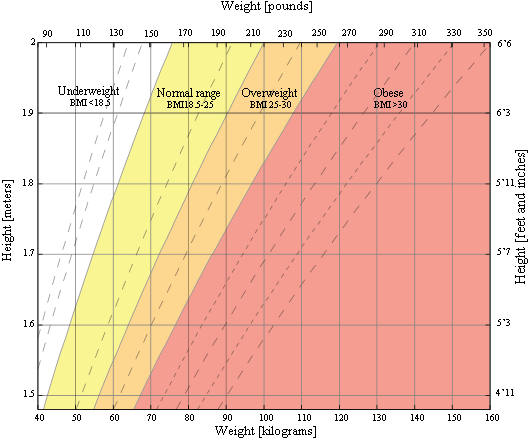
In children and adolescents (under 20 years old), BMI is assessed using percentiles based on age and gender, as these factors affect growth and development. Using adult BMI categories for young people would not provide an accurate health assessment.
But a low BMI isn’t necessarily a sign of good health either. Those in the underweight category may face risks like malnutrition, weakened immune function, reduced bone density, fertility issues, and in older adults, a higher likelihood of frailty or injury⁽⁵⁾.
It’s not about labeling someone “too big” or “too small.” It’s about offering a starting point for a deeper health conversation.
⚠️ Important Notes:
- These ranges apply to most adults, but not all. They do not account for age, sex, ethnicity, or muscle mass, which can affect interpretation.
- For children and teens, BMI is interpreted differently — using percentile charts based on age and gender, which we’ll cover later in the article.
Obesity and Health Risks
When BMI crosses the threshold into the obese range (30.0 and above), it’s not just a number on a chart — it’s a signal. Obesity is linked to a wide range of chronic health conditions that can reduce life expectancy, affect quality of life, and increase healthcare costs at both personal and national levels.
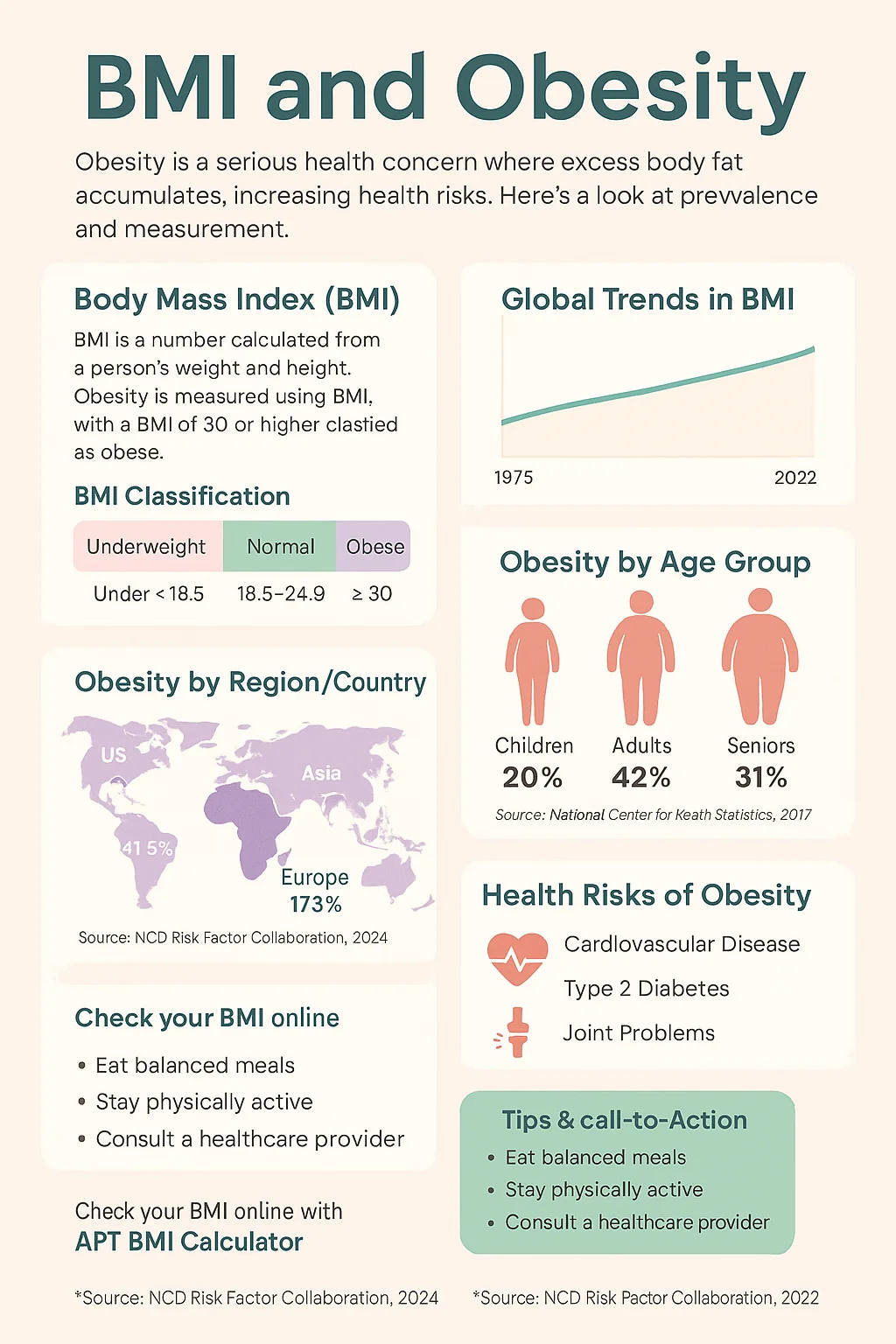
According to the Centers for Disease Control and Prevention, obesity increases your risk for⁽⁷⁾:
- Type 2 Diabetes: Obesity is the single most significant risk factor. Excess body fat, especially around the abdomen, can cause insulin resistance — a major trigger for the onset of type 2 diabetes.
- Hypertension (High Blood Pressure): Excess fat can disrupt hormonal balance, increasing blood volume and pressure on artery walls.
- Cardiovascular Diseases: Obesity is strongly correlated with heart disease, stroke, and high cholesterol. Fat tissue produces inflammatory substances that may damage blood vessels and raise LDL (“bad”) cholesterol levels.
- Certain Types of Cancer: Research links obesity to increased risk of cancers like breast, colon, kidney, and liver⁽⁸⁾.
- Sleep Apnea: Fat accumulation around the neck and airways can restrict breathing during sleep, leading to fatigue, heart complications, and reduced oxygen levels.
- Joint Problems and Osteoarthritis: Extra body weight places stress on weight-bearing joints like the knees and hips, accelerating wear and tear.
These risks increase incrementally with higher BMI classes. For example, someone with a BMI of 35 faces greater health complications than someone with a BMI of 30 — especially if the weight is carried around the abdomen.
💡 Did you know?
As of the latest CDC survey, more than 42% of adults in the United States⁽⁹⁾ are considered obese. That’s nearly 1 in 2 adults — a staggering figure that reflects not only lifestyle shifts but also structural and environmental health challenges.
Limitations of BMI
For all its popularity, BMI is a blunt tool. While it can flag potential weight-related health risks at a population level, it doesn’t account for the complex, individual realities of body composition, age, ethnicity, or fitness level.
1. It Doesn’t Differentiate Between Fat and Muscle
One of the most common criticisms of BMI is that it doesn’t distinguish fat from lean mass. This is particularly problematic for athletes or individuals with high muscle mass. A well-trained bodybuilder may be classified as "obese" by BMI standards — despite having a low body fat percentage and excellent cardiovascular health.
The reverse is also true: someone with a “normal” BMI may have excess visceral fat (fat around the organs), which is associated with higher health risks⁽¹⁰⁾ — even if their BMI says they’re in the clear.
2. It’s Not Well-Suited for All Demographics
BMI works best as a general screening tool for non-pregnant adults aged 20 to 65. Outside of this group, it loses some of its reliability.
- Children and Teens: Growth and development vary significantly with age and sex, so BMI must be interpreted using percentile charts. That’s why tools like a bmi calculator by age and gender are more appropriate for pediatric assessments⁽¹¹⁾.
- Older Adults: With age, people tend to lose muscle mass and gain fat — but BMI doesn’t capture that shift. An elderly adult may have a “normal” BMI but still face high health risks due to sarcopenia (muscle loss).
- Ethnic Differences: Some populations are more likely to develop health problems at lower BMIs. For instance, people of Asian descent may experience diabetes or cardiovascular issues at a BMI under 25. That’s led some countries to adopt population-specific BMI cutoffs⁽¹²⁾.
3. It Can Be Misleading in Clinical Settings
In healthcare, context matters. Relying solely on BMI without looking deeper may lead to underdiagnosing or overdiagnosing patients. Someone might fall into a “healthy” BMI range but have metabolic syndrome, high cholesterol, or poor cardiorespiratory fitness.
Likewise, a person classified as overweight might be metabolically healthy, active, and well-nourished. That’s why most doctors now consider BMI a starting point, not an end point.
BMI by Age and Gender
Although BMI is calculated using the same formula for everyone, it doesn’t affect all bodies equally. Age and gender significantly influence how we carry weight, how much body fat we naturally have, and how health risks manifest at different BMI levels. That’s why interpreting BMI in isolation can sometimes be misleading — especially if we ignore those important context clues.
But does BMI reflect the differences between male and female bodies?
On average, females naturally have a higher percentage of body fat than males, even when both fall within the same BMI range. This difference is not only normal — it’s biologically essential for hormone regulation and reproductive health. So, a BMI of 23 might look very different on a woman compared to a man in terms of fat distribution and metabolic profile. That’s why many platforms now offer bmi calculator female or womens bmi calculator versions, which help tailor BMI feedback more accurately by considering gender-based health norms and fat composition patterns.
In contrast, men tend to carry more lean muscle mass and store fat differently — often around the abdomen. This means they might reach higher BMIs before crossing into at-risk territory, yet still be metabolically active and healthy. That’s why tools like the bmi index male calculator or bmi calculator male are increasingly used in clinical and fitness settings — they help bridge the gap between numbers and reality.
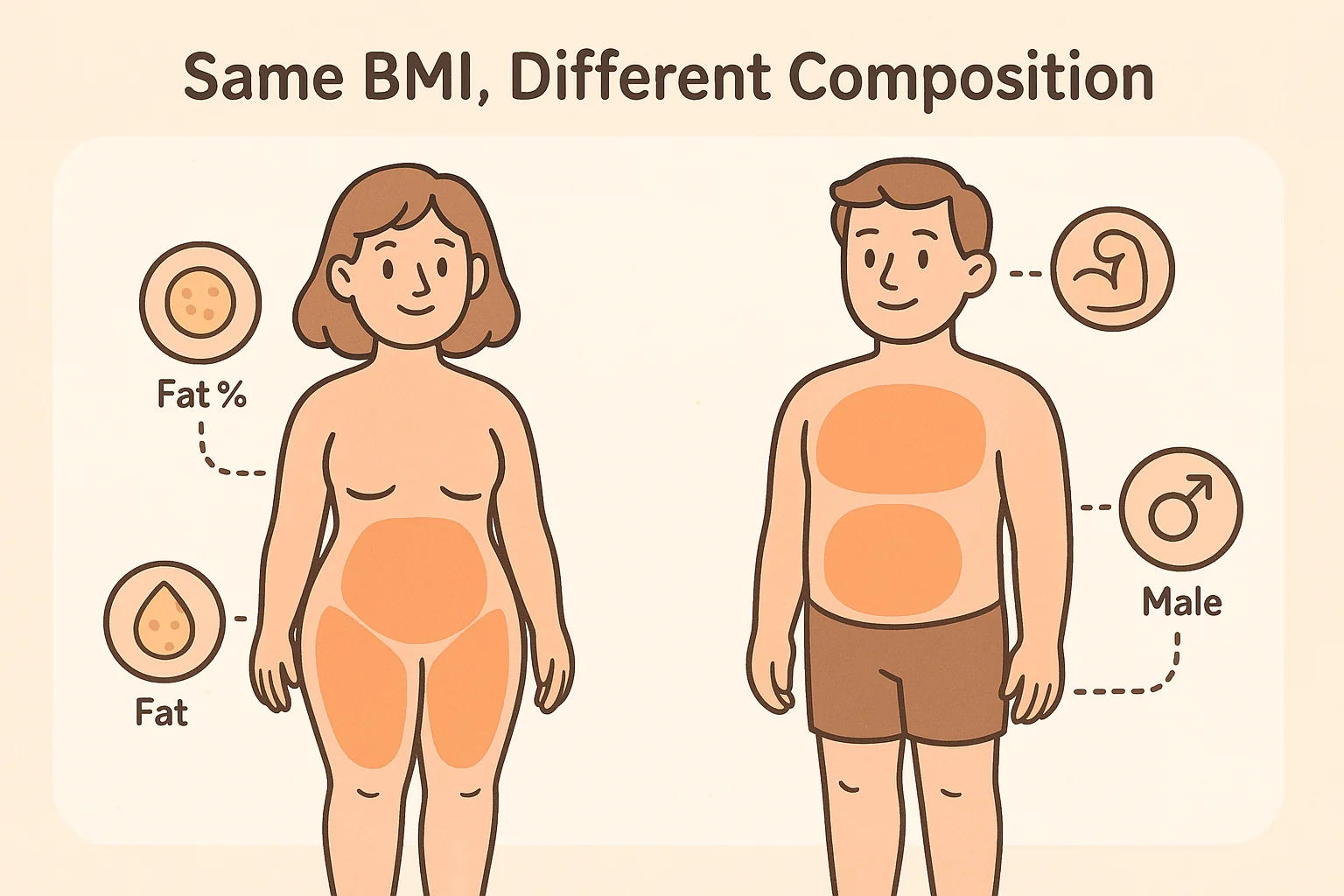
And what about age — does BMI still tell the same story as we grow older?
As we age, body composition shifts even if our weight stays the same. Muscle mass naturally decreases, while fat mass tends to increase — a process known as sarcopenia. This is especially important for older adults, who might have a “normal” BMI but low muscle reserves, putting them at higher risk for frailty, insulin resistance, and even injury from falls. For younger individuals, especially teens and children, BMI interpretation becomes even more complex. Their bodies are still developing, which is why medical professionals rely on age - and sex-specific growth charts, not fixed adult ranges. A bmi calculator by age and gender is essential in pediatric or adolescent care to ensure that healthy development is being measured appropriately⁽¹³⁾.
Take this for example: a 21-year-old male athlete with a BMI of 28 might technically fall into the “overweight” category. But if that number comes from dense muscle mass, not excess fat, he’s likely far healthier than someone with the same BMI who has a sedentary lifestyle. On the flip side, a 45-year-old woman with a BMI of 22 could still be at risk if her body fat is mostly visceral — the type stored around internal organs, which poses greater health risks than fat under the skin.
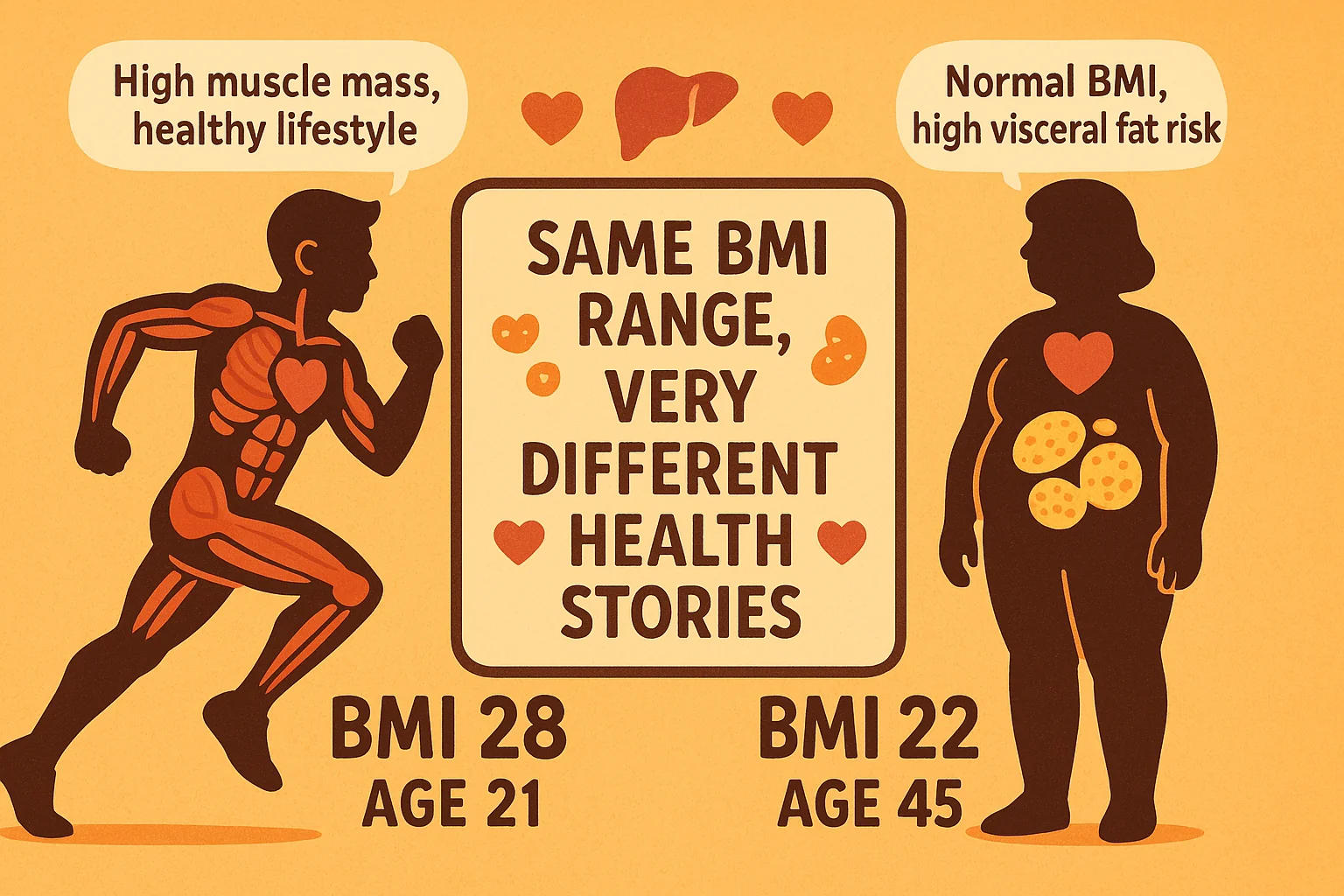
All of this points to one conclusion: BMI isn't one-size-fits-all. Age and gender deeply influence what the numbers mean — and how they should guide decisions about health.
Source:
⁽¹⁾ Keys A, et al. "Indices of relative weight and obesity." Journal of Chronic Diseases, 1972.
⁽²⁾ Centers for Disease Control and Prevention (CDC). “About Adult BMI.”
⁽³⁾ World Health Organization (WHO). “Body mass index - BMI.”
⁽⁴⁾ Centers for Disease Control and Prevention (CDC). “The Health Effects of Overweight and Obesity.”
⁽⁵⁾ National Institutes of Health (NIH). “Underweight: Health Risks and Tips.”
⁽⁶⁾ CDC. “About Child and Teen BMI.”
⁽⁷⁾ CDC. “Adult Obesity Causes & Consequences.”
⁽⁸⁾ National Cancer Institute. “Obesity and Cancer Fact Sheet.”
⁽⁹⁾ CDC. “Prevalence of Obesity and Severe Obesity Among Adults: United States, 2017–2020.”
⁽¹⁰⁾ Harvard School of Public Health. “Limitations of BMI.”
⁽¹¹⁾ CDC. “BMI for Children and Teens.”
⁽¹²⁾ WHO Expert Consultation. “Appropriate BMI for Asian populations.” Lancet, 2004.

